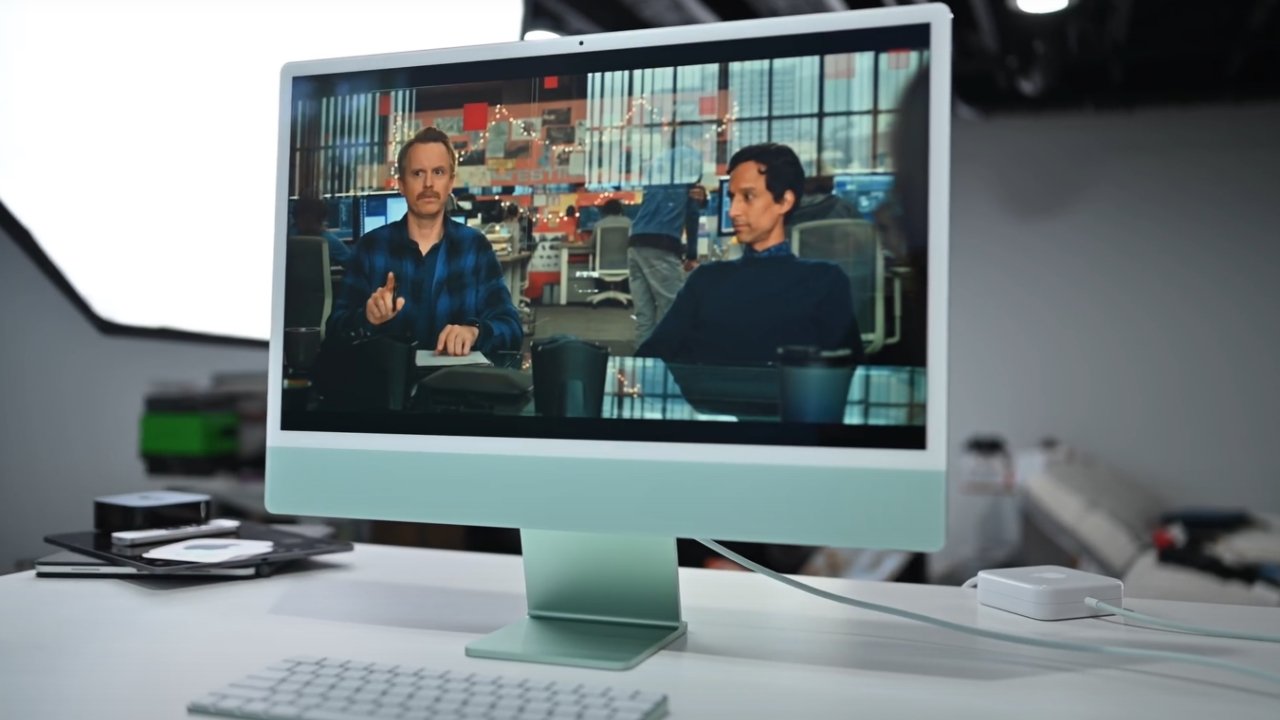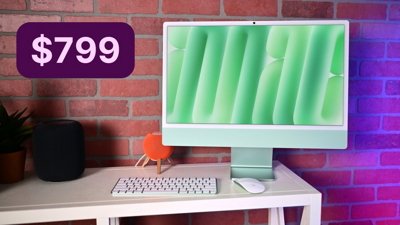The external design of the iMac had not changed much in 13 years, with minor alterations to screen size or aspect ratio being the most noticeable updates. The 24-inch iMac broke that cycle with a new thin and vibrant lineup released in 2021.
The redesigned 2021 iMac replaced the 21.5-inch iMac 4K that ran Intel processors. A larger model has been rumored since this 24-inch release, but nothing has been announced.
Apple released the updated iMac with an M1 processor and an all-new design in 2021. It was then updated with the M3 in 2023, but nothing else was changed about the product.
A new iMac model with a larger 30-inch or larger display could be announced at any point. It was initially rumored shortly after the 2020 launch, but it isn't clear if or when such a model will be revealed.
One rumor placed a 32-inch iMac reveal at the end of 2024, but that didn't happen. The timeline shifted forward, with supply chain analyst Ming-Chi Kuo stating that a 32-inch model would arrive in 2025 despite Apple's repeated references to 24 inches being enough.
The 24-inch iMac was updated with an M4 processor and a Nano Texture option in October 2024. Every M-series iMac can run Apple Intelligence, which launched with macOS Sequoia.
24-inch iMac Features
This thin-and-light desktop runs macOS and can perform most tasks needed by everyday consumers. While a Mac Studio might be needed for more intense workflows, most users will get more than enough done with the M4 in this iMac.
Design
The 24-inch iMac is 11.5mm thick — about the same thickness as the original iPhone. It no longer has a prominent chin with an Apple logo, and gone are the thick black bezels surrounding the display. The 2021 iMac is a slim and light desktop PC with seven color options and powerful Apple Silicon.
Available colors:
- Blue
- Green
- Pink
- Silver
- Yellow
- Orange
- Purple
The color design splits into two tones — a muted color on the front "chin" of the display and a more saturated color on the rear of the computer. The front has a slim white bezel surrounding the screen. The muted color and white bezel are used to maintain display color balance and reduce distractions.
The desktop stand is the same muted color as the faceplate and can be traded for a VESA mount at purchase. It doesn't have an adjustable height, but the entire iMac can be tilted for better viewing angles.
The colorful design bleeds over to its peripherals as well. The magnetic power cable is color-matched to the vibrant back panel, and the keyboard and mouse have colored highlights to match.
At less than 10 pounds, this desktop is easy to move around. Apple anticipated this with a new magnetic power connector. Users aren't exactly expected to pop one of these iMacs out at a cafe, but the plug-and-play nature of its power cable means carrying an iMac to and from the office is not only feasible but easy.
Display and audio
Apple increased the resolution to match the size of the new display. Moving from 21.5 inches to 24 inches necessitated an increase from 4K to 4.5K to maintain Retina resolution. It is 4480 by 2520 pixels with a 218 PPI.
The display is otherwise unchanged. It has 500 nits of brightness, a P3 wide color gamut, and True Tone technology.
Customers can add an optional Nano Texture coating to the display to reduce reflections and glare.
Users can enjoy their 4K iTunes content with color-accurate reproduction and excellent sound. Apple has packed six dynamic speakers into the 24-inch iMac monitor. Two pairs of force-canceling woofers are balanced with a high-performance tweeter, which works together to create room-filling sound.
Apple says the 24-inch iMac supports spatial audio when playing video with Dolby Atmos. This means that all audio will sound like it's coming from a specific direction around you, and when you turn your head, you'll still perceive audio from the correct direction.
Spatial audio is a feature in AirPods Pro and AirPods Max that creates a 3D sound space within the listening environment. As the user turns their head, it sounds like the audio is still coming from the iPhone or iPad speakers.
Performance
Apple didn't change much about the 24-inch iMac in 2024 beyond swapping out the M1 processor for an M3 processor. The upgrade brings several new features with a more powerful CPU and GPU.
The M3 iMac is twice as fast as the M1 iMac in pure performance. The GPU gains Dynamic Caching, which enables powerful features like hardware-accelerated ray tracing and mesh mapping for high-fidelity gaming.
The base M3 processor has an 8-core CPU and an 8-core GPU. Customers can upgrade to the 10-core GPU option, which also means an additional two USB 3 ports.
Base models can get up to 24GB of RAM and up to 1TB of storage. The 10-core GPU models can get up to 2TB of storage, but have the same 24GB of RAM maximum.
Like other base M-series chips, the iMac can only run one external display. Apple introduced a dual display mode for the M3 MacBook Air, but it requires the laptop to be in clamshell mode.
Apple brought M4 to the iMac in October 2024 for another performance boost.
Ports and I/O
The ports included with the 24-inch iMac differ depending on which model customers choose. Both models have two USB 4/Thunderbolt ports, but only the more expensive model has two additional USB 3 ports.
The M3 models have Bluetooth 5.3 and Wi-Fi 6E.
The magnetic power cable connects to an external power brick that also houses a Gigabit Ethernet port. Only the more expensive models come with an Ethernet port, however.
There is a headphone jack on the left side of the iMac because there wasn't enough depth to place it in the back. A headphone jack needs 14mm of space, where the 24-inch iMac has only 11.5mm of depth.
It has a 1080p webcam with special image processing performed by the M1. Apple says it is the best webcam ever placed in a Mac.
Apple apparently considered placing Face ID in the redesigned model since its display thickness would have enough space for the technology. However, the idea was scrapped before final production began of the 2021 models for unknown reasons.
A color-matched Magic Keyboard comes with both iMacs, but only the more expensive model has integrated Touch ID in the keyboard. Customers can upgrade their keyboard or add a color-matched Magic Mouse or Magic Trackpad at checkout. These accessories still ship with Lightning ports.
There is a three-mic array that Apple says provides studio-quality recordings. The beamforming mics ignore background noise so the audio heard on calls and in recordings is clear.
M1 24-inch iMac review: Computing power for the masses
Thanks to the efficiency of the M1 processor, Apple was arguably able to execute the most significant overhaul to its consumer-focused Mac in years. The 24-inch iMac ditches the aging design of its predecessor for a thin and colorful exterior reminiscent of the iPad Pro.
Review: Design
Apple's first three Macs with Apple Silicon kept the previous design to ensure the initial transition was focused on getting the processor right, not on flashy design updates. After the great reception of the M1-based Macs, Apple has decided now is the time for a design change.
The curved back and prominent chin have been replaced with a flat rectangle with a small chin and no Apple logo. There are seven color variants with two-tone schemes. The display is wrapped in a thin off-white bezel.
The screen increased from 21.5 inches to 24 inches with a 4.5K display. The entire computer rests in the chin while the rear of the display houses the speaker components.
Review: Ports
The thin design doesn't leave much room for ports, so the usual plethora of ports has been reduced to four USB type-C ports. The two USB 4/Thunderbolt ports are standard on every 24-inch iMac, but the additional two USB 3 ports are only included on higher configurations.
The iMac has a newly designed power cable that uses magnets to keep it in place. This cable runs to a power brick that has an Ethernet port built-in, but it is only included by default on higher-end iMacs. Moving Ethernet to the power brick enables a simplified port configuration on the machine and better cable management for cables that are rarely touched.
We liked the placement of the headphone jack on the side of the machine. Rather than having to get up and fiddle with a port in the rear of the display, we could easily plug the headphones in without searching.
Apple included the latest wireless standards in the 24-inch iMac. They have Wi-Fi 6 and Bluetooth 5.0 for connecting wireless devices.
Review: Processor
There are two variants of the M1 processor depending on which tier of iMac you choose. Both have 8-core CPUs, with the difference being 7-core or 8-core GPUs.
The better tier also comes with Touch ID in the Magic Keyboard and Ethernet in the power brick by default. The cheaper model has options to upgrade those accessories at checkout.
Our testing showed the M1 processor handily beat out the base model Intel-based iMacs in single and multi-core operations. The M1 could not compete against dedicated graphics in the 27-inch iMac, but the score reflects its ability to handle graphics well.
Review: Big changes
The 24-inch iMac enters the market as an un-upgradable appliance computer. It doesn't replace a professional workstation like the 27-inch iMac or iMac Pro, but it didn't need to. To us, it seems this is a desktop targeted at bringing iOS lovers to the Mac.
Apple, of course, remains the master of the up-sell. The $1,299 model brings customers to the table, but the $1,499 quickly becomes affordable once a Touch ID keyboard and Ethernet-capable power brick are added.
For most, there's a lot to like with the first Apple Silicon iMac. At any level, it is an excellent machine that won't appeal to the most power-hungry or the Intel-bound. For those folks, you probably need to wait it out for another generation or two, as the M-series chip is ultimately incremented, and your Intel-stuck software migrates to Apple Silicon.
And, for the devout, there's a lot of call-backs to older Macs, like color, white bezels that started on the G4 iMac, and near-silent computing continuing to have a renaissance, after getting left behind more than 15 years ago with the G5 and Intel Macs.
Pros
- New thinner and colorful design
- Powerful M1 chip
- Headphone jack is easier to reach
- Touch ID on Magic Keyboard
Cons
- Limited port count, especially at $1,299
- Optional Ethernet moved to power brick
- Still has a chin
- Not upgradable
24-inch iMac Price
The 24-inch iMac with a 4.5K display ships with a base configuration of an M3 with an 8-core CPU, 8-core GPU, 8GB of RAM, and 256GB of storage for $1,299. Customers can increase the storage up to 1TB, get up to 24GB of RAM, or add a Touch ID Magic Keyboard at checkout.
The higher-end model with an 8-core CPU, 10-core GPU, 8GB of RAM, and 256GB of internal storage costs $1,499. This model comes with the Touch ID-enabled Magic Keyboard by default, and users can increase the storage up to 2TB or get up to 24GB of RAM at checkout.
 |
 |
M1 24-inch iMac Prices















 William Gallagher
William Gallagher
 Malcolm Owen
Malcolm Owen
 Charles Martin
Charles Martin
 Christine McKee
Christine McKee

 Amber Neely
Amber Neely

 Appleinsider Staff
Appleinsider Staff

 Andrew O'Hara
Andrew O'Hara